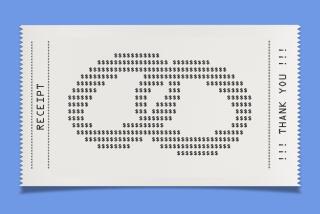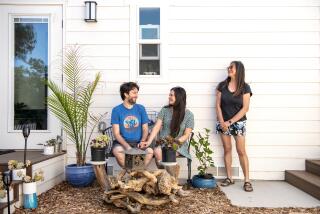The dream house will have to wait
- Share via
Eddie Cuevas and Michelle Siqueiros Cuevas have come a long way from their humble upbringings.
Eddie grew up in a one-bedroom apartment in Highland Park with his six siblings. His mother, a seamstress, and his father, a janitor, immigrated from Mexico and struggled to support their family. As a child, Eddie knew it was difficult for them to buy him even the smallest toy.
Michelle, raised by her Mexican immigrant mother in Echo Park, also grew up without much money. Because her mother couldn’t afford a baby-sitter during the summer, Michelle often tagged along to work with her and watched her sew upholstery on high-end furniture.
“I didn’t realize I was poor until I found out other kids had their own bedrooms,” says Michelle, who slept in the living room of their tiny apartment.
But all of that hasn’t held either of them back. Eddie, 36, is pursuing a master’s degree in education at UCLA, where Michelle, 35, earned a master’s in urban planning.
Both are the first in their families to attend college. Now, they want another piece of the American dream: a house.
“My mother asks me when are we going to buy a house every month,” says Michelle, an associate director for the Campaign for College Opportunity, a nonprofit organization that works to ensure minorities and low-income students have a chance to go to college.
Aside from family pressure, the Cuevases feel the heat in other ways. Once Eddie finishes school next year, the couple and their two children will have to move out of their $1,300-a month UCLA housing unit in Mar Vista. Their three-bedroom apartment is roomy. But they’re yearning for a backyard for their rambunctious 6-year-old son, Aidan.
The Cuevases so far have managed their finances handily. Thanks to scholarships, the couple’s student loan burden is relatively low at $23,000. They also have a $10,000 car loan.
They faithfully contribute 10% of their income to retirement accounts, which have accrued about $63,000. They’re also squirreling away $300 a month for their children’s college educations.
The downside: They have just $13,000 in other savings.
“It’s remarkable how far they’ve come financially,” says Jennifer Hartman, a fee-only financial planner with Greenleaf Financial Group in Los Angeles. “They’re almost ready to buy a house. But they’re not quite there.”
In a year or two, however, Hartman believes the couple could save enough to put down 5% to 10% on a home.
The Cuevases had considered diving in and buying a home with a faddish zero-money-down loan. That made Hartman wince. If they scraped together 5% or 10% for a down payment, they would save money in the long run, she says.
They’ll also have equity in the home, buffering them against losses if housing prices declined and they were forced to sell.
The Cuevases also thought about tapping their 401(k) accounts for a home down payment -- an idea that Hartman quickly rejected.
Those 401(k) loans may be a snap to get, and the interest rates are temptingly low as well. But when you borrow from your retirement fund, that money isn’t doing what it should be doing -- namely, earning investment returns to help pay your bills later in life.
“I’m dead set against people borrowing from their retirement accounts to pay for other things,” Hartman says.
The Cuevases also are eyeing the real estate market warily, wondering about the timing of their hoped-for purchase.
Patrick Veling, president of Real Data Strategies, a real estate research firm in Brea, says the market is woozy after soaring home values earlier this decade.
Although some communities are seeing values continue to rise, the residential real estate market overall is in a slump -- and some experts believe it has not yet hit bottom. In June, home prices were lower in two-thirds of Southern California’s ZIP Codes compared with the same month a year earlier, according to DataQuick Information Systems.
For the Cuevases, this means that there is no rush to buy, Hartman says.
But because they are planning to live in their home for years to come, they shouldn’t worry too much about gyrations in the market, she says.
“A house is a place you live in. It’s never a pure investment,” she says.
To help the family psychologically and financially ease into a home, Hartman advises them to pretend as if they were already paying a mortgage and to live frugally.
Eddie used to make about $40,000 a year, but he has since quit work to focus on school full time. Now, they live on Michelle’s salary of $94,000 a year -- stretching their dollars by eating brown bag lunches and closely tracking their expenses.
“We don’t need the latest gadgets or clothes,” Michelle says.
Their one splurge is spending $3,000 to $4,000 every summer to travel to Mexico for several weeks to visit Eddie’s family in Jocotepec and Michelle’s in Guadalajara.
Once Eddie begins his job as a history teacher at West Adams Preparatory High School next month, Hartman estimates he’ll take home $37,000 after taxes and retirement contributions. If the Cuevases save all of his paycheck, within a year they should have enough to put down 5% on a home. That’s still a big expense, with the median price of a Southland home topping $500,000.
Typically, home buyers who put down less than 20% on a home purchase must pay a higher interest rate on their mortgage and take out private mortgage insurance that protects the lender should the borrower default on payments.
That’s why Hartman says she recommends that they take out a “piggyback” loan so they can put 20% down.
For example, if the Cuevases wanted to buy a $500,000 house, they would kick in $25,000 of their savings -- 5% of the purchase price -- and take out a loan for $75,000 for the remaining 15%.
The interest rate on this piggyback loan would be about 8%. Even so, in the end they would save about $400 a month because the piggyback allows them to get a cheaper mortgage and they won’t have to spend about $260 a month for private mortgage insurance, said Mark Friedes, a mortgage broker with Pacific Trust Group in Los Angeles.
In addition, the interest payments on the piggyback loan can be deducted from their income tax, he noted.
Hartman recommended several other financial moves for the couple. Instead of parking their $13,000 in savings in a checking account that earns a paltry 1% in interest, they should move it into an online banking account that can offer rates as high as 4.5%.
Although the couple innately save, she also advises them to create a household budget. The Cuevases should budget for some individual “fun” money so they don’t elbow each other over Eddie’s splurges on Starbucks coffee or Michelle’s charitable gifts.
Hartman also recommends that the couple draft a will and buy life insurance. Hartman advises that they buy $1 million in coverage for Michelle and $500,000 for Eddie.
Based on Hartman’s recommendations, the couple have moved ahead with estate planning and selected a guardian for their children. They’re primed to save Eddie’s salary. And if they don’t find a home they adore, they’ll wait. Reflecting on his finances, Eddie remembers the lessons he learned growing up in a family of immigrants.
“You have to work hard for everything,” he says. “You have to earn even the little things.”
--
Do you need a money makeover? Each month the Sunday Business section gives readers a chance to have their financial situations sized up by professional advisors at no charge. To be considered, send an e-mail to makeover@latimes.com. Include a brief description of your financial goals and a daytime phone number. Information you send us will be shared with others. You can also send a letter to Makeover, Business Section, Los Angeles Times, 202 W. 1st St., Los Angeles, CA 90012.
--
Begin text of infobox
This week’s makeover
The couple: Eddie Cuevas, 36, and Michelle Siqueiros Cuevas, 35
Income: $94,000
Financial goals: Buy a home, save for their children’s college educations, purchase life insurance, draft a will.
Savings: $63,000 in 401(k) retirement accounts, $12,000 in college funds, $13,000 in checking.
Debts: $23,000 in student loans, $10,000 car loan.
Recommendations: Don’t jump into the home market just yet. Keep saving for another year to accrue enough to put at least 5% down on a home. Buy $1.5 million in life insurance: $1 million for Michelle and $500,000 for Eddie. Draft a will and choose a guardian for their young children.
About the planner: Jennifer Hartman is a fee-only financial planner and principal of Greenleaf Financial Group in Los Angeles.
More to Read
Sign up for Essential California
The most important California stories and recommendations in your inbox every morning.
You may occasionally receive promotional content from the Los Angeles Times.






